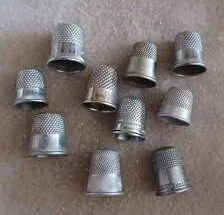Thimbles have a long and interesting history that goes back to ancient times. These small tools were first made to protect fingers while sewing, and their story includes many amazing changes and cultural meanings.

Archaeologists have found the oldest known thimbles in Pompeii, from the 1st century AD. These bronze thimbles were the early start of a useful tool that has lasted through the ages.
Evolving Materials and Designs
As time went on, thimbles changed in materials and designs. In medieval times, people made them from leather, wood, and metal. By the 14th century, Nuremberg, Germany, became a major center for making brass thimbles.
In the 17th century, thimbles made of silver and gold became popular among rich people. These fancy thimbles were not just useful but also symbols of wealth and status.
Thimbles in Different Trades and Cultures
Thimbles weren’t only used for sewing. They were also used in other crafts like bookbinding, leatherworking, and lace-making. These handy tools helped with protection and accuracy in different trades.
Thimbles also showed up in popular culture and stories. In the well-known story of “Peter Pan,” a thimble was used as a symbol for a kiss. Plus, the classic board game Monopoly originally had a thimble as one of its game pieces, showing how common thimbles were in early 20th-century homes.
Treasured Artifacts and Cultural Celebrations
Vintage thimbles are very valuable to collectors and enthusiasts today. Their history, variety of designs, and detailed craftsmanship make them highly desirable. Many collectors focus on thimbles from certain time periods or made from specific materials like porcelain, bone china, or sterling silver.
Many museums and exhibits around the world celebrate thimbles. For example, the Fingerhut Museum in Creglingen, Germany, has thousands of thimbles from different times and places. These displays honor the rich history and cultural importance of thimbles.
The Thimble’s Enduring Appeal
Even today, thimbles still inspire artists and crafters. People value them for both their usefulness and their look. Modern thimble makers often mix old techniques with new designs, respecting the history of thimbles while also appealing to today’s styles.
In conclusion, vintage sewing thimbles are more than just useful tools. They are historical artifacts that show how craftsmanship, social status, and cultural practices have changed over time. Collectors and enthusiasts celebrate their lasting legacy.
